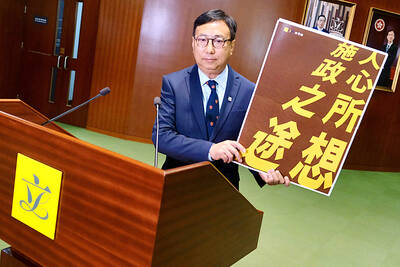Chinese President Xi Jinping (習近平) agreed to meet the Dalai Lama during a state visit to India in 2014, but the plan was quashed by Delhi, the Buddhist spiritual leader has said.
The claim, which could signal that in the early years of his term Xi was open to the most radical shift in China’s Tibet policy in decades, was made during an interview for a book by Indian journalist Sonia Singh, an executive at Delhi-based television channel NDTV.
The Dalai Lama appeared to let the detail slip casually in the interview in November last year, according to an audio recording.
“I have a brief meeting with [Indian] prime minister Narendra Modi [and] when Xi Jinping came to Delhi, I also wanted a meeting with him,” he said. “So I already have some connection, some contact directly through my friend. So Xi Jinping agreed, but the Indian government was a little cautious.”
“That would have been a landmark meeting if it had happened,” Singh replied.
The Dalai Lama appears to agree before the talking moves on.
The stray remark might have been attributed to a misunderstanding or the use of imprecise language by the Dalai Lama, 83, who speaks English fluently, but with a heavy accent.
Singh said that she sent the transcript of the interview to his office for approval and received no objections.
Nor has Tibet’s government-in-exile, based in the Indian Himalayan city of Dharamshala, issued a denial or any other comment since Singh’s book, Defining India: Through Their Eyes, was released in Delhi last week.
The Chinese Ministry of Foreign Affairs said in a statement sent to the Guardian that the claim was “sheer nonsense.”
“With regards to the 14th Dalai Lama, our policy has been consistent and clear,” the statement said.
The 14th Dalai Lama, born Tenzin Gyatso, has lived in India since fleeing Tibet in 1959 after a failed uprising.
The Dalai Lama does not advocate independence for Tibet, but more autonomy for the region.
Successive Chinese leaders have portrayed him as a dangerous “splittist” and “wolf in monk’s robes,” and sought to prop up alternative Buddhist leaders.
The Chinese Communist Party says it has the right to approve his successor.
China says it liberated Tibet in 1950, overturning feudal practices and bringing the remote region into the modern era.
Rights advocates say Tibetans face cultural and religious repression, as Beijing has launched a harsh, years-long campaign to stifle dissent, namely self-immolations by protesting Buddhist monks.
Beijing says Tibetans are free to practice their own religion and culture.
The Dalai Lama’s exile in India has been a persistent source of discord — and, for Delhi, leverage — in relations between Asia’s two rising powers.
“If it’s correct, it’s a very major development,” said Robbie Barnett, former director of the Modern Tibetan Studies Program at Columbia University. “I’ve never seen any suggestion of a [Chinese official] meeting with the Dalai Lama, let alone at this level.”
“It would completely overturn [Beijing’s] standard working method for dealing with Tibet, which since 1994 has been to insult the Dalai Lama literally at every opportunity, while also holding talks with his representatives, which have also mainly turned into attacking the Dalai Lama,” Barnett said.
A handful of academics and policy advisers had written articles after Xi came to power in 2012 urging a relaxing of the Tibet policy of former Chinese president Hu Jintao (胡錦濤), Barnett said.
However, “we never saw any sign or rumor that they were successful. This is the only indication that there might have been a possibility of a major rethink,” he said.
Amitabh Mathur, a high-ranking former Indian intelligence official who served as an adviser to the Indian government on Tibetan affairs from 2015 to last year 2018, said he had heard that the Dalai Lama had lobbied for a meeting with Xi during his first visit to India five years ago, but was not aware if the offer had been accepted or if India had scuttled it.
Delhi would have had reason to object to the meeting, Mathur said.
“I think it is a bit much to ask of the Indian government, which had recently been elected and had the Chinese premier visiting for the first time,” Mathur said. “It is a bit much to ask to take the focus away completely from what was a bilateral visit.”
Rather than signaling a shift in policy, agreeing to the meeting might have been part of a long-term Chinese campaign to exploit points of tension in the relationship between Delhi and the Tibetan leader, he said.
They might have accepted the invitation knowing India would be likely to veto it.
“The Chinese would certainly like to drive a wedge between His Holiness and the government of India,” Mathur said.
The Modi government in its first years was seen to be willing to risk Chinese opprobrium by playing the “Tibet card,” said Manoj Joshi, a fellow at the Delhi-based Observer Research Foundation.
Modi invited senior Tibetan leaders to his inauguration and sent ministers to receive the Dalai Lama at events.
However, the situation had changed by the time the Dalai Lama gave his interview last year, amid a push by Indian diplomats to improve relations with Beijing.
Senior Indian officials have been asked to keep their distance from events surrounding the 60th anniversary this year of Tibet’s abortive uprising against Chinese rule.
“A certain coolness has crept in,” Joshi said.
Barnett said that in revealing the meeting plans, it was possible that the Dalai Lama had been sending a message to those in his movement who dismissed his strategy of trying to engage with Xi’s administration.
Equally, the spiritual leader might have just unintentionally said too much.
Since 2014, China under Xi has maintained its policies toward Tibet. In a white paper released in March, the Chinese government excluded a reference found in earlier policy documents to being open to engaging with the Dalai Lama.
The fact the Dalai Lama’s office allowed the release of the information also suggested the window for meeting had closed, Barnett said.
“It does suggest they’ve given up any hope that it could happen again,” he said.
For Xi, who launched his Belt and Road Initiative in late 2013, agreeing to such a meeting could have had diplomatic benefits.
“The main thing the Chinese would gain from it is soft power from the world, because the Dalai Lama is seen as a person of peace and the world sees China as oppressing people,” said Adrian Zenz, who focuses on ethnic policies in China.
Although India hosts the Dalai Lama, it has not been outspoken about oppression in India. Authorities last year banned Tibetans from marking the 60th anniversary of the failed uprising against Chinese rule.
“They don’t want to rock the boat,” Zenz said.
India “tends to favor relations with China, at least over Tibetan issues in general,” he said.

‘CHILD PORNOGRAPHY’: The doll on Shein’s Web site measure about 80cm in height, and it was holding a teddy bear in a photo published by a daily newspaper France’s anti-fraud unit on Saturday said it had reported Asian e-commerce giant Shein (希音) for selling what it described as “sex dolls with a childlike appearance.” The French Directorate General for Competition, Consumer Affairs and Fraud Control (DGCCRF) said in a statement that the “description and categorization” of the items on Shein’s Web site “make it difficult to doubt the child pornography nature of the content.” Shortly after the statement, Shein announced that the dolls in question had been withdrawn from its platform and that it had launched an internal inquiry. On its Web site, Le Parisien daily published a

China’s Shenzhou-20 crewed spacecraft has delayed its return mission to Earth after the vessel was possibly hit by tiny bits of space debris, the country’s human spaceflight agency said yesterday, an unusual situation that could disrupt the operation of the country’s space station Tiangong. An impact analysis and risk assessment are underway, the China Manned Space Agency (CMSA) said in a statement, without providing a new schedule for the return mission, which was originally set to land in northern China yesterday. The delay highlights the danger to space travel posed by increasing amounts of debris, such as discarded launch vehicles or vessel

RUBBER STAMP? The latest legislative session was the most productive in the number of bills passed, but critics attributed it to a lack of dissenting voices On their last day at work, Hong Kong’s lawmakers — the first batch chosen under Beijing’s mantra of “patriots administering Hong Kong” — posed for group pictures, celebrating a job well done after four years of opposition-free politics. However, despite their smiles, about one-third of the Legislative Council will not seek another term in next month’s election, with the self-described non-establishment figure Tik Chi-yuen (狄志遠) being among those bowing out. “It used to be that [the legislature] had the benefit of free expression... Now it is more uniform. There are multiple voices, but they are not diverse enough,” Tik said, comparing it

Prime ministers, presidents and royalty on Saturday descended on Cairo to attend the spectacle-laden inauguration of a sprawling new museum built near the pyramids to house one of the world’s richest collections of antiquities. The inauguration of the Grand Egyptian Museum, or GEM, marks the end of a two-decade construction effort hampered by the Arab Spring uprisings, the COVID-19 pandemic and wars in neighboring countries. “We’ve all dreamed of this project and whether it would really come true,” Egyptian Prime Minister Mostafa Madbouly told a news conference, calling the museum a “gift from Egypt to the whole world from a